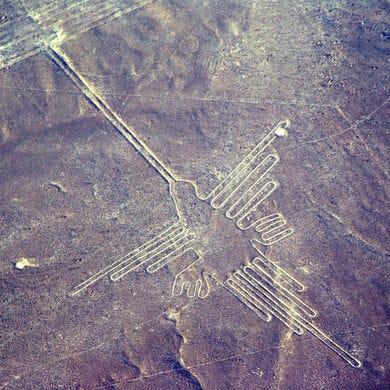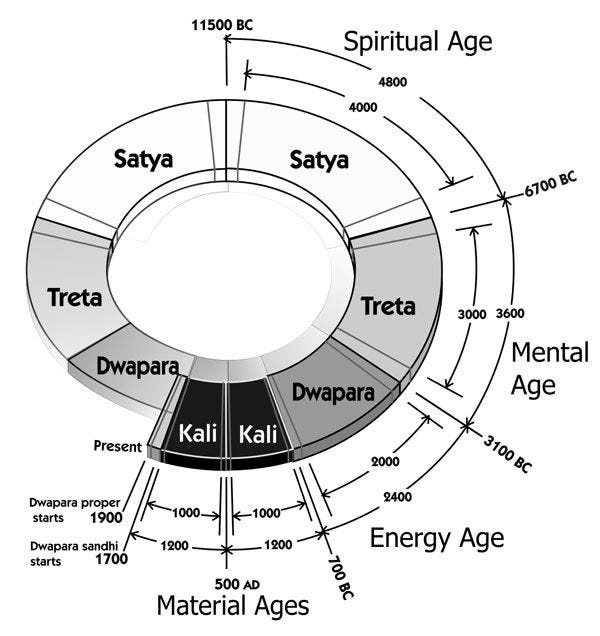What if Time Was Cyclical? It Would Change the Way You Look at Everything
 Image by Javier Rodriguez from Pixabay
Image by Javier Rodriguez from Pixabay
‘Yugas’ offer a new way to understand our past and future.
Was the pyramid of Giza built with primitive tools like stones and ropes?
Why did primitive humans build structures that only made sense when seen from hundreds of feet in the air?
How do ancient scriptures contain advanced knowledge of geography, mathematics, geometry, astrology, and medicine?
Why do ancient languages like Sanskrit, developed millenia ago, form the basis of most languages we use today?
If these questions trouble you, as they did me, don’t worry. Once I share with you a new way of looking at Time, you too will unravel the mysteries of these seeming anomalies.
A few weeks ago, fascinated by Yuval Harari, I read his renowned, much-recommended book Sapiens. Even though I enjoyed it, I took every concept with a pinch of salt.
The current linear, Darwinian view that many historians hold dearly was the reason for my skepticism. According to this theory, man evolved from apes, was a hunter-gatherer for millennia, and finally began agriculture at some point. From there on, he started organizing into communities, and conduct business and trade as usual.
Man kept on evolving, discovered new things, and here we are today in the technologically advanced 21st century.
Now let’s look at what we believe the future holds for us. Many people argue we’re heading towards a Singularity where A.I. takes over the world, and men become cyborgs with technical capabilities existing alongside biological.
However, it seems a mere extrapolation of what we see now. And we’re extrapolating because we have no idea how the future looks like.
Why don’t we have any idea? Because we think time to be linear. The linearity of time implies that the future will always be more advanced than the past and there’s no way to foresee the direction we’re going in.
But all these changes if we start viewing time as cyclical — which gives answers to a lot of questions that the current theory doesn’t address.
Cyclical time implies that people slowly evolve, then devolve, and then evolve again. These cycles of time are called “Yugas” or ages. Many ancient civilizations like Hindus, pre-Christian Greeks, the Chinese, and the Aztecs are also devout believers of the cyclicity of time.
According to ancient Indian teachings, these cycles are four in number — Satya, Treta, Dwapara, Kali (from the highest to the lowest). The ancient Greeks similarly called it the Gold, Silver, Copper, and Iron ages. The names may be different, but the cyclic view of time is inherent in a glaringly large number of ancient cultures.
The Anomalies of the Past
What we know about history is based on the evidence we find and what we make of it. But these are only explanations, not the truth. History is all about debating narratives to explain past events.
For instance, after thousands of years of conjecture, we still don’t know the purpose of building the pyramid of Giza. It’s too meticulously developed to be a burial ground. It portrays highly advanced architecture that no “hunter-gatherer” man could ever build, even if thousands of them worked together over decades.
They couldn’t possibly have cut, dressed, and placed 2.5 million blocks at an average of one block every four minutes. Some of these blocks are as heavy as 70 tons and are raised to a height of almost half the Empire State Building.
Even with the apparent complexity of the structure, we believe this was only accomplished using wood, stone, and copper tools. These instances (and many more which you can find in the book Yugas) are conveniently set aside as anomalies that don’t fit in the current linear model of growth.
Another example is the formation of Sanskrit that dates back to at least 7000 BC and still has grammar sophisticated enough to be considered as the best language for programming and AI by NASA.
Yet another anomaly is the depictions of animals “drawn” on the ground in the Nazca plains. In the figure below, one can only see it as a hummingbird from hundreds of feet in the air. To do that, one would need a helicopter or a plane, which didn’t exist when these were created.
Why would people toil away building things they couldn’t see — unless they did have a way to see them!

Hummingbird (Source)
All these examples are convenient ‘anomalies’. But when enough anomalies come to the surface they collectively challenge the current theory of evolution.
The Concept of the Yugas
The concept of the Yugas was explained by Sri Yukteswar, an enlightened soul and Indian astrologer in his book The Holy Science the teachings of which I recounted recently.

He explained that we go through discernible ages or yugas, which leads to a change in prevailing human consciousness. When mankind’s consciousness changes, so do civilization and human development.
Since the yugas see time as cyclical, they not only indicate that future ages will be highly advanced but also that the past ages were equally advanced.
According to it, mankind entered Dwapara Yuga in 1900 AD. It is also called the energy age and will last for 2,400 years. The age before this was Kali Yuga. The ages that succeed in Dwapara are Treta and Satya (in that order).
Each yuga has transition periods from and to the next yuga. These are called the dawns and twilight of that yuga.
Each transition period lasts for 1/10th of the yuga’s length. The length of Dwapara is 2000. Thus, the length of each transition period is 200 (1/10th of 2000). In total, Dwapara yuga consists of 2,400 years (200+2,000+200).
By this logic, Kali Yuga ended in 1700. The 200-year transition began. And mankind entered into Dwapara yuga in 1900 AD.
Adding together all yugas, one arc of the yuga cycle requires 12,000 years. (1200 +2400+3600+4800; as we’ll see below). Then the descending arc also takes 12,000 years. Hence, the whole cycle takes 24,000 years.
How Do the Yugas Come Into the Picture?
The derivation of the yugas is purely scientific and perhaps astronomically difficult for most people to grasp. Let’s see it in brief.
Moons revolve around their planets and planets turning on their axes revolve with their moons around the sun. But then, Sri Yukteswar writes
“The sun also has another motion by which it revolves round a grand centre called Bishnunavi which is the seat of the creative power Brahma the universal magnetism. It informs us further that this Brahma, the universal magnetism, regulates Dharma the mental virtues of the internal world.
“When the sun during its revolution round its dual comes to the place nearest to this grand centre the seat of Brahmaa, this Dharma the mental virtue becomes so much developed that man can easily comprehend all even the spirit beyond this visible creation.”
Thus, what age we’re in is determined by how close we are to the Bishnunavi. Higher ages experience enhanced mental and spiritual capabilities because divine magnetism emanating from the Bishnunavi is strongest at that point.
The last time this happened was in 11,500 BC. 12,000 years later, when the descending arc of the cycle completed in 500 AD, we were farthest from the Bishnunavi. Thereby, mankind was at its lowest point of development.
Keep in mind though that we’re only talking about the consciousness of mankind as a whole. In every yuga, we find saints as well as sinners. It’s not that everyone will be wise and enlightened in Satya yuga, the highest age. The yuga only gives a general trend.
That said, let’s learn more about the different yugas in brief.
Kali Yuga — Age of Materialism
Kali (Dark) Yuga is an age where man can only perceive gross material realities. The general consciousness of mankind is mentally and spiritually least evolved. People live lives of passive acceptance. Willpower goes for a toss.
During this age, much ancient knowledge was destroyed which makes it difficult for Kali Yuga people to know their rich history. Alexander the Great destroyed 12,000 volumes of the Magi, Persians destroyed literary works of Athens, Chinese Emperor Chin Shi Huang-ti had all books in China burned, Julius Caesar destroyed the library at Druid College, and so on.
Religion in this age is dogmatic and preaches of a judgmental God to be pleased by ritual and sacrifice.
The majority of people in Kali Yuga were farmers, herdsmen, laborers, artisans, conscripted soldiers, servants, or slaves. Pleasures were simple, sensory, and earthy — eating, drinking, sex. Education was also limited.
Dwapara Yuga — Age of Energy
Dwapara Yuga is the present age. Kali Yuga ended in 1700 AD and then after 200 years of transition, in 1900, we entered Dwapara proper. It’s the age of energy since mankind is better able to harness energy underlying matter.
Right after the start of the 20th century, in 1905, Einstein proved all matter is condensed energy (E=MC² ). The last century also saw an influx of new religions, philosophies, and scientific discoveries like quantum physics.
This is also the age where man builds “Space Annihilators” — objects that help us transcend the limitations of space. We already have a lot of them. The Internet is perhaps the most apparent one. Not only will we make the world a smaller place but also the whole Universe. Elon Musk, for instance, is hell-bent on getting to Mars. A millennia later, we may travel to or inhabit those planets.
Just about a century ago, we didn’t know how to fly across the globe. Today, it’s no big deal. Who knows what’ll happen in another hundred years.
Treta Yuga — Age of Thought
In Treta Yuga, we enter the age of thought. Just as in Dwapara, man discovered the presence of energy behind all matter, in Treta Yuga, man discovers the presence of thoughts behind energy.
Mankind begins to develop potent mental powers like telekinesis, telepathy, manifestation, and so on. Most people extrapolate our future to be a slew of cyborgs and AI ruling over humans. But as we enter Treta Yuga, man no longer needs tools to change reality. And thus, technology may diminish as mental (and spiritual) powers increase.
Why use technology to lift a big rock, when your mental powers alone may be enough? Why use the phone to talk to people when you can speak by mere thought-transference? Thus, Treta Yuga is not necessarily more technologically advanced than Dwapara, but more spiritually advanced.
This is also the age when man builds “Time Annihilators.” The book Yugas, states,
One of the limitations of time that we accept today is that it “takes time” for certain things to happen. Plants grow at a certain pace, healing requires time to happen, children need a lengthy childhood to grow up, people need time to learn. In Treta Yuga, it may be that many processes we now believe absolutely will “take time,” could be sped up or even eliminated by the agency of thought
Perhaps, by the power of thought, a tree could be induced to grow a fruit more or less instantaneously. Healing in Treta Yuga may be accomplished immediately by helping others change their thoughts, rather than by relying on slow, “natural” processes that require more time.
The long journey of youth may be sped up or eliminated as well. Childhood is in many ways a crash course in coming into attunement with the body, mind, and feelings. If a child’s attunement could be sped up by direct transference of knowledge from adults, perhaps, as a result, the body’s growth would be sped up as well.
Many physicists often ask themselves “Why does time flow forward?” which implies that, at least theoretically, time can flow backward! Even Einstein said
“Time is not at all what it seems. It does not flow in only one direction, and the future exists simultaneously with the past.”
I know all these examples seem speculative. And they’re supposed to! Since our consciousness isn’t developed enough to perceive them. Discussions of higher ages always seem speculative — you’ll see that once you read the next paragraph about Satya Yuga!
Satya Yuga
Phew! We made it to Satya Yuga. To be frank, it’s quite above our paygrade to be thinking of Satya Yuga. It’s the age not of energy or thought, but Spirit.
Spirit is currently incomprehensible to us. As Sri Yukteswar writes in Holy Science, in Satya Yuga, “The human intellect can comprehend all, even God the Spirit beyond this visible world.”
This age is so advanced that God is part of our everyday experience. The veil of delusion between man and God is almost non-existent. We see God in everyone and everything. Our intuition and mental abilities are fully developed.
People live for hundreds of years in perfect health, and are even considered ‘demi-gods’. They can communicate with every living thing including animals and nature. Further, everyone communicates in a universal language.
Since it’s so far ahead of our own levels of consciousness, it may feel ridiculous. But again, I’d like to remind you that many things we take for granted today were myths 300 years ago. Who says, the same rate of mental and spiritual progress (if not faster) will not continue and go beyond our current imagination?
Final Thoughts
The yugas present a completely different view of time itself. Many archeologists, paleontologists, linguists, and so on are now taking a closer look at the assumptions that we’ve taken for granted for a long time. They’re applying new techniques to re-examine ancient artifacts and sites.
Every time we re-analyze one of them, we find that they’ve existed for even a longer time in the past. And the more we find these shreds of evidence, the harder they become to ignore.
The concept of the yugas offers a high vision for our future as well. And the vision is not as bleak as we think it to be.
I know you have a lot of doubts. After all, this is completely different from what most of us believe. To clear them, I’d suggest picking up a copy of The Yugas: Keys to Understanding Our Hidden Past, Emerging Present, and Future Enlightenment.
Don’t fret, I’m not telling you to change your worldview. I’m only telling you to accept the possibility that the prevalent one could be false. That’s not too much to ask, is it?